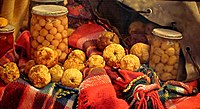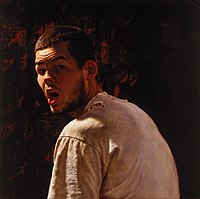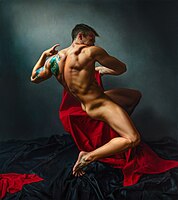|
Tomáš Kubík (painter)
Tomáš Kubík (born 15 October 1977) is a Czech painter. He is graduate of the Studio of Classical Painting Techniques of Prof. Zdeněk Beran at the Academy of Fine Arts in Prague. Formerly, he was also active in dance and movement theatre, played the flute and worked as a teacher at a private painting school he co-founded. LifeTomáš Kubík comes from a family of an artist, advertising graphic designer and director of the local cultural centre in Pelhřimov, who led both his sons to visual arts and music.[1] After finishing primary school he attended the Václav Hollar Art School in Prague in 1992–1996, where he mastered graphic techniques, modelling and photography in addition to drawing and painting. He went to copy masterpieces at the National Gallery and painted landscapes in the open air with his classmate Zdeněk Daňek.[1] Since his youth he has played the flute. After graduating from secondary art school he was admitted to the Studio of Classical Painting Techniques of Prof. Zdeněk Beran at the Academy of Fine Arts in Prague. His classmates at that time were Markéta Urbanová, Dagmar Hamsíková, Jan Mikulka, Marek Slavík and Daniel Pitín. During the six years that Kubík spent in Beran's studio (1996–2002), he was able to fully exercise his extraordinary technical skills and his natural inclination towards the work of the old masters. He devoted himself mainly to still life painting and live model drawing, and his works, including his earliest ones, were regularly exhibited at the Academy of Fine Arts for their extraordinary bravura of execution. The school offered opportunities for internships abroad, which he took full advantage of, visiting exhibitions of Rembrandt, Caravaggio and Michelangelo during his studies. He was also influenced by contemporary artists such as Francis Bacon and Lucian Freud, and therefore continued his studies at the Milan Knížák Studio of Intermedia in 2002–2004.[2] During his studies, Tomáš Kubík was already recognised as an exceptional talent when in his second year he received the Atelier Prize and the academyRector's Prize (1998) and in 2000 the Minister of Education's prize for exceptional achievements in painting. In the same year, he succeeded in the competition for a representative portrait of Karel Malý for the portrait gallery of the rectors of Charles University in Karolinum.[3] His painting Scenes from Married Life was purchased by the National Gallery in Prague in 2004. Paintings from his first foreign exhibition in the USA (2002), which received excellent reviews in the local press,[4] were sold off to private collections. After graduating from the academy, he became active in Dance and movement theatre but never abandoned painting and painted smaller formats, portrait commissions, illustrations and storyboards/comics for advertising and film agencies. He later used his experience with digital painting and its combination with photomontage (matte painting) to prepare compositions in the Michelangelo project.[5] In 2017 he got married and in 2019 his son Nicholas was born. Tomáš Kubík also works as a teacher of painting. In 2010, he began taking students for individual painting lessons in his studio and in 2012 he co-founded an art school in Prague 1, which he ran until 2018.[6] At that time, he left his shares to his partner so that he could devote himself entirely to painting. Tomáš Kubík's first participation in a competition organised by the Royal Society of Portrait Painters in London brought him a special Award for Classically Inspired Portraiture (Highly Commended) from Burke's Peerage Foundation in 2021 for his portrait of David in the Renaissance style.[7] The jury also selected another portrait by Kubík, Valeria, for the competition. In 2021, Kubík's painting Inner Rage was selected for the European Museum of Modern Art's (MEAM) annual show in Barcelona, Figurativas 2021.[8] Awards
WorkDuring his studies at secondary school, Tomáš Kubík painted en plein air and gravitated towards impressionist painting. In his first year at the academy, he devoted himself mostly to still life painting, and in his first series of paintings, which began originally in a post-impressionist style after Cézanne, he switched to realistic Trompe-l'œil painting as the arranged apples gradually deteriorated. Eventually, a series of five still lifes with apples and compotes on a checkered wool blanket, entitled "Study of Decomposition" (1997), was created on this theme. His veristic still lifes depict mostly quite ordinary objects, such as a dry aloe in a pot (Still Life with Cactus, 1997) or bunches of onions (Onions I and II, 1997, 1998), entirely in keeping with the aesthetic advocated by Prof. Beran.[9][10]
Foreign travels and immediate impressions of paintings by Rembrandt, Caravaggio or Michelangelo, as well as the Belvedere Torso,[11] were a significant inspiration for his own work. The marble Greek torso from the first century BC influenced generations of artists, starting with the Italian Renaissance, with its perfection (Tomáš Kubík, Belvedere Torso I, from the series "Michelangelo Project", 2020). Kubík moved on to portrait painting with an extensive series of portrait studies of his expressions in the mirror, which he eventually translated into the "group self-portrait" Clone (1998-1999), in which he repeats the self-portrait several times in a kind of deaf-mute flurry, studying his own face in a complex lighting regime. Here he applied Rembrandt's psychologization of figures, Caravaggio's chiaroscuro[12] and the attention to detail and imitation of folk types characteristic of Dutch paintings. Kubík's figurative painting is characterised by the contrast between neo-Baroque theatricality and the psychological uncertainty or ironic self-examination of figures reacting to the outside world.[2] He then used the self-portrait again in a series of preparatory sketches for a portrait of a soldier wearing a tank helmet (Self-Portrait in Helmet, 1997–1998), in The Large Self-Portrait in the Studio (1997), in a portrait study after Vermeer (Vermeer's Saliva, 1997–1998), or in the expressive composition Inner Rage - Self-Portrait with dummy (2001).
At that time, he began to use a box with artificial lighting, modelled on Tintoretto, to study chiaroscuro and painted a series of nudes based on a live model and a loose series of figurative compositions on the theme of human relationships (1999-2001). The first of a pair of large-scale paintings, Scenes from Married Life (1999-2000), was purchased by the National Gallery in Prague in 2004, while the second composition on a similar theme, entitled Mary Magdalene, was created between 200-2001 and was exhibited at a major survey of European and American figurative painting, the Biennial Figurativas at the MEAM Museum in Barcelona (2019).[13] Kubík enjoys multi-figural compositions, where he can use his technical skills and individual characterization of figures previously studied in preparatory sketches in the studio (Dinner in the Jordaens Style , 1998–1999, The Four Wise Men, 1999).
In Portrait Document in the Renaissance Style, a series of paintings from 2020 to 2021, inspired by the early Renaissance portrait paintings of Albrecht Dürer and Hans Holbein, he creates sets of portraits of his contemporaries that would ultimately serve as a kind of time-lapse document.[14] Two portraits from this series (David in Renaissance Style, 2020, Valeria, 2021[15]) were selected for a competition held by The Royal Society of Portrait Painters in London, and the first of these won the Burke's Peerage Foundation award. In the series Death and the Girl (2018), he used a white plaster cast of a face as a model which allows him to study the subtle nuances of relief under different lighting. This is a traditional academic discipline that introduced students to the ancient heritage and grisaille drawing technique. Yet the model itself evokes the tension between the impersonal plaster and the emotionally charged, romantic subject matter.[16] Tomáš Kubík often inserts some extraneous details into paintings, that are inspired by classical paintings and created with the same technique, to make it clear that they are contemporary works.[17] Michelangelo's idealised male nudes from the ceiling of the Sistine Chapel, called Ignudi, served as compositional models for his hyperrealistic male nudes.[18] To portray them, he somewhat provocatively chose contemporary human types from the fitness centre, with pronounced musculature, tattoos and uniformly tanned skin from the solarium. In doing so, the painter had to transpose the original mannerist composition, intended for the ceiling, into a real, believable and unobtrusive position.[5]
Drawings
Representation in collections
ExhibitionsAuthor's
Collective (selection)
References
Sources
Collective catalogues
External linksWikimedia Commons has media related to Tomáš Kubík. |
||||||||||||























